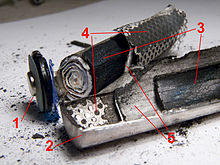| This article needs additional citations for verification. Please help improve this article by adding citations to reliable sources. Unsourced material may be challenged and removed. Find sources: "Jelly roll" battery – news · newspapers · books · scholar · JSTOR (June 2023) (Learn how and when to remove this message) |

- positive terminal
- outer metal casing (also negative terminal)
- positive electrode
- negative electrode with current collector (metal grid, connected to metal casing)
- separator (between electrodes)
The jelly roll or Swiss roll design is the design used in the majority of cylindrical rechargeable batteries, including nickel–cadmium (Ni-Cd), nickel-metal hydride (Ni-MH), and lithium-ion (Li-ion). The design has this name because the cross section of the battery looks like a Swiss roll.
In this design, an insulating sheet is laid down, then a thin layer of an anode material is laid down, a separator layer is applied, and a cathode material is layered on top. This sandwich is then rolled up and inserted into a hollow cylinder casing. The battery is sealed, metal contacts are attached, and an optional button top is applied if the battery is intended to replace an AAA/AA/C/D alkaline battery. A label with the brand name is then applied, or a blank protective label, often green (for Ni-MH) or blue (for Ni-Cd) for a generic or OEM battery.
Occasionally, the design is also used for primary (non-rechargeable) batteries, like lithium iron disulfide (Li-FeS2) patented by Energizer, although most common primary batteries use the conventional rod-paste-tube design, like the zinc-carbon and its successor the alkaline battery.
The Swiss roll design is likewise used for the plates of cylindrical capacitors.
References
- Tatum, Jeremy. "5.20: Real Capacitors - Physics LibreTexts". Retrieved 8 June 2023.
- "Supercapacitors: Electrical Characteristics, Modeling, Applications, and Future Trends". IEEE Access. doi:10.1109/ACCESS.2019.2908558. hdl:2454/34938. Retrieved 8 June 2023.
Most commercial supercapacitor cells are cylindrical. This shape is achieved by rolling up a jelly roll consisting of two aluminum foil current collectors with the electrode active material deposited on both sides.